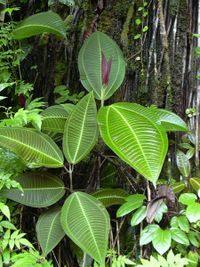- Miconia calvescens
-
- "Bush Currant" redirects here. Not to be confused with Currant Bush (Carissa spinarum).
Miconia calvescens 
Scientific classification Kingdom: Plantae Division: Magnoliophyta Class: Magnoliopsida Order: Myrtales Family: Melastomataceae Genus: Miconia Species: M. calvescens Binomial name Miconia calvescens
DC.The velvet tree, miconia, or bush currant (Miconia calvescens) is a species of flowering plant in the family Melastomataceae. It is native to Mexico and Central and South America[1] but is best known for being arguably the worst invasive plant in Hawaii, where it is commonly referred to as the "purple plague", and threatens to destroy entire ecosystems. It is also similarly damaging in other tropical locales such as Tahiti. The tree can grow to a height of 15 metres (49 ft) and has very large leaves, each up to 1 metre (3.3 ft) in length. Its purple and green leaves with flashy white veining made it attractive as an ornamental, and it was imported to Hawaii and other new areas in the mid-twentieth century. Once it dispersed into the tropical moist forests it took hold vigorously, invaded any spot in the understory that received patches of sunlight, and became a noxious weed.
Miconia trees can flower several times a year and bear fruit simultaneously. The flowers are large inflorescences of light pink blossoms and the tiny purple fruits are half a centimeter in diameter and packed with minuscule seeds. The sweet fruits are attractive to birds and other animals which disperse the seeds. This heavy seed production and potential for long-distance dispersal help make miconia a threat. The seeds lie dormant in the soil of the forest, and whenever a break in the canopy allows sun to shine through to a patch of soil the seeds there undergo germination. Once the plants grow to full height, their enormous leaves shade out all the space below them, preventing any other plant from growing nearby. It also has a shallow root system that facilitates soil erosion.
Hawaiian populations of miconia were first discovered in the 1990s, and since the plant's invasive potential was already well-known, control and eradication efforts began immediately there. Uprooting and herbicides are used to remove plants, but biological control has not yet met with great success. Teams of volunteers often lead expeditions into the forest to remove miconia plants by hand.
The plant has become an ecological disaster on Tahiti. One quarter of the rainforest there is now made up of miconia stands. For this reason, it is frequently called the "green cancer" on the island.
References
- ^ "Miconia calvescens". Germplasm Resources Information Network. United States Department of Agriculture. 1997-12-10. http://www.ars-grin.gov/cgi-bin/npgs/html/taxon.pl?409651. Retrieved 2009-02-07.
External links
- Miconia calvescens information and links from the Hawaiian Ecosystems at Risk project
- Miconia calvescens detailed information and references from the Pacific Ecosystems at Risk project
- Miconia calvescens images: a gallery of copyright-free high-resolution photographs
- Miconia calvescens
Categories:- Miconia
- Invasive plant species
- Invasive plant species in Hawaii
- Naturalized trees of Hawaii
- Trees of Bolivia
- Trees of Brazil
- Trees of Colombia
- Trees of Ecuador
- Trees of Guatemala
- Trees of Mexico
- Trees of Panama
- Trees of Paraguay
- Trees of Peru
- Melastomataceae stubs
- Tree stubs
Wikimedia Foundation. 2010.
